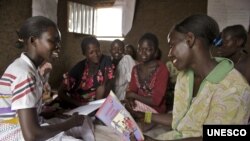NAIROBI —
A new report from the United Nations shows progress toward education goals in Africa is stagnating, leaving many young people deprived of quality schooling and high-paying jobs.
According to the 2012 Education for All monitoring report, nearly half of the world's children who do not go to school reside in just 12 countries, eight of which are in sub-Saharan Africa.
And while the numbers are improving in other parts of the world, the number of out-of-school African children has actually increased in the last couple of years - and is now at 31 million.
The statistics for African school-aged children are part of a troubling trend highlighted in the annual report commissioned by the United Nations education agency UNESCO.
Pauline Rose, the director of the report, tells VOA that progress in reaching the Education for All goals first set in 2000 has stagnated in recent years, as reaching those in need has become more challenging.
“As we have made improvements in getting more children into school, those who are left behind are those that are hardest to reach," Rose explained. "So in Kenya, they are the pastoralist children, they are the children who are living in urban slums. They are those who are less easy for the government to reach through conventional methods.”
Rose says even in conventional schools, the quality of education is often lacking and young people who receive a basic education are still unprepared for the work force.
“There's an insufficient link between what goes on in the education systems and what is needed in the world of work,” noted Rose.
Many young people across Africa end up self-employed, doing odd jobs in the informal sector, earning just enough to survive, but still remaining below the poverty line.
The report notes that in Cameroon, around 40 percent of young people with a secondary education are living in so-called “working poverty.”
Rose says one of the solutions is for African governments to promote education programs that compliment their countries' economic strategies, providing technical training that will give students the skills they need to earn better paying jobs.
She says some countries have already benefited from this approach.
“It's this ambition that is really driving change that we do see in countries like Ethiopia and elsewhere in Africa that have already experienced high levels of economic growth and can do so even more if they continue to have a combined strategy of this kind,” Rose said.
Overall, the picture for Africa remains hopeful.
According to the report, the countries that have improved the most on education during the last decade are, in order, Mozambique, Ethiopia and Ghana.
Lesotho and Malawi have also made noticeable strides in the same time period, moving from the low to middle rankings compared to countries around the world.
According to the 2012 Education for All monitoring report, nearly half of the world's children who do not go to school reside in just 12 countries, eight of which are in sub-Saharan Africa.
And while the numbers are improving in other parts of the world, the number of out-of-school African children has actually increased in the last couple of years - and is now at 31 million.
The statistics for African school-aged children are part of a troubling trend highlighted in the annual report commissioned by the United Nations education agency UNESCO.
Pauline Rose, the director of the report, tells VOA that progress in reaching the Education for All goals first set in 2000 has stagnated in recent years, as reaching those in need has become more challenging.
“As we have made improvements in getting more children into school, those who are left behind are those that are hardest to reach," Rose explained. "So in Kenya, they are the pastoralist children, they are the children who are living in urban slums. They are those who are less easy for the government to reach through conventional methods.”
Rose says even in conventional schools, the quality of education is often lacking and young people who receive a basic education are still unprepared for the work force.
“There's an insufficient link between what goes on in the education systems and what is needed in the world of work,” noted Rose.
Many young people across Africa end up self-employed, doing odd jobs in the informal sector, earning just enough to survive, but still remaining below the poverty line.
The report notes that in Cameroon, around 40 percent of young people with a secondary education are living in so-called “working poverty.”
Rose says one of the solutions is for African governments to promote education programs that compliment their countries' economic strategies, providing technical training that will give students the skills they need to earn better paying jobs.
She says some countries have already benefited from this approach.
“It's this ambition that is really driving change that we do see in countries like Ethiopia and elsewhere in Africa that have already experienced high levels of economic growth and can do so even more if they continue to have a combined strategy of this kind,” Rose said.
Overall, the picture for Africa remains hopeful.
According to the report, the countries that have improved the most on education during the last decade are, in order, Mozambique, Ethiopia and Ghana.
Lesotho and Malawi have also made noticeable strides in the same time period, moving from the low to middle rankings compared to countries around the world.









